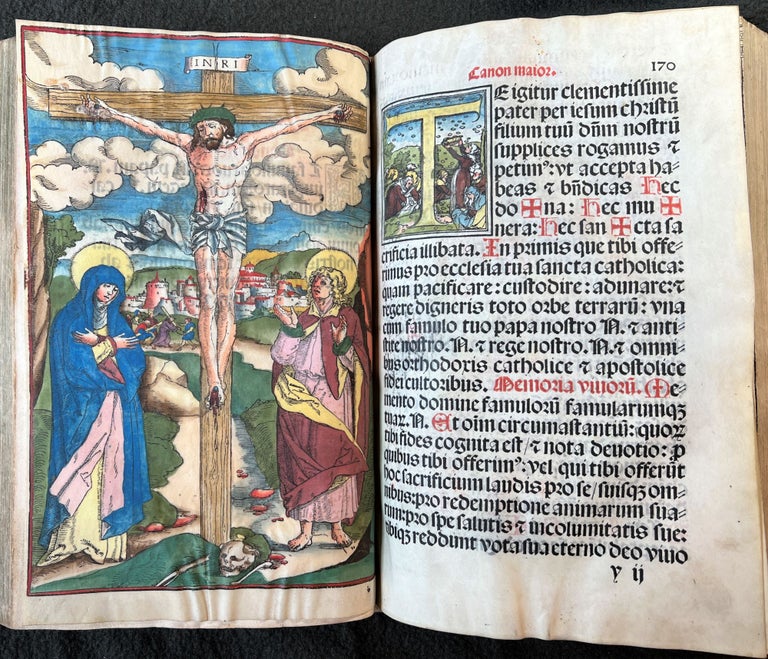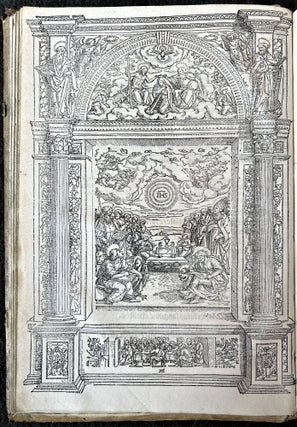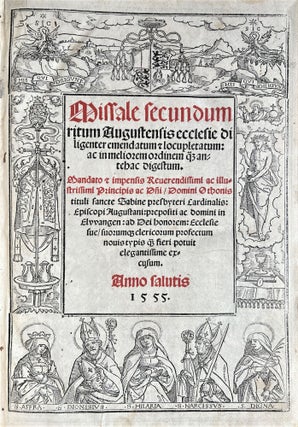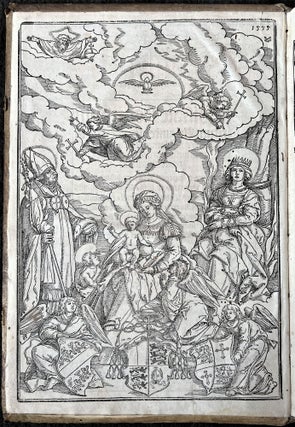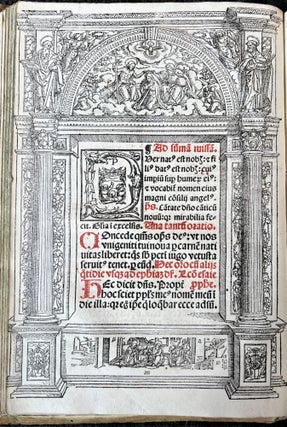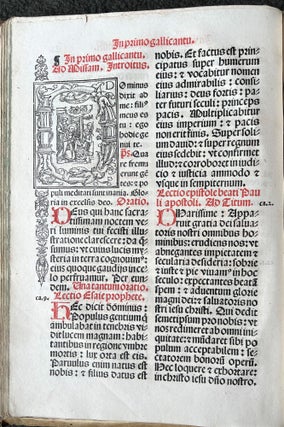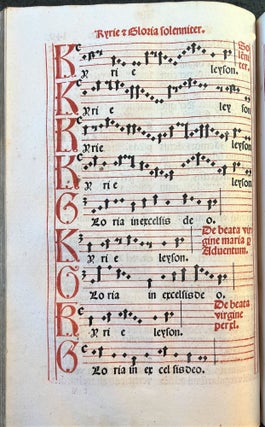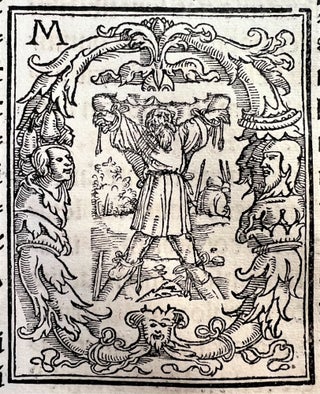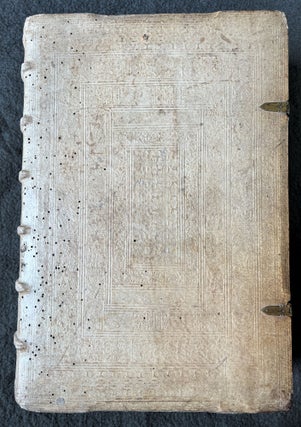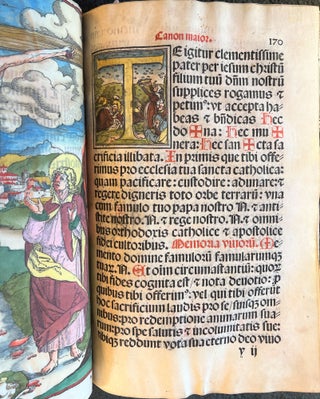Missale secundum ritum Augustensis ecclesie. Dillingen: Sebald Mayer, 1555.
Folio (355 x 249 mm). [28], 471 leaves (of 472, final blank removed). Printed in red and black in 4 different sizes of gothic type, in two columns (except the prologue, calendar, verse to priests and colophon), printed shoulder-notes, 34 pages of printed music on red staves within vertical double rules, metalcut calligraphic initials in red; the canon quire printed on vellum, with full-page crucifixion woodcut, large historiated initial, and paschal lamb roundel with fine contemporary illumination; woodcut illustrations by Matthias Gerung: title border incorporating at top the arms of the Cardinal Prince-Bishop Otto Truchsess von Waldburg, at the left side the Bishop’s vestments and at the right side the suffering Christ holding a chalice to receive his blood, at bottom five patron saints of Augsburg (Afra, Dionysius, Hilaria, Narcissus and Digna); on title verso a full-page woodcut of the Virgin and Child with Saints Ulrich and Afra, dated 1555; full-page illustration opening the Missal, containing a central scene of the Adoration of the Sacrament of the Altar by the Apostles, Evangelists and Doctors, set within an architectural border with the Coronation of the Virgin and Saints at top, and in the bottom socle a small rectangular inset woodcut of the Last Supper, this page border used 10 more times, each with a different small Biblical cut at the foot; initials printed from several sets: two very ornate larger sets (93 x 75 mm. and 63 x 54 mm.), incorporating a small xylographic “guide” roman letter for ease of reading (one, an S, using instead a patriarchal cross), all enclosing a variety of small woodcuts; smaller initials (most 33 x 31 mm.) from two main sets, one also including a small roman capital; ornamental marginal extenders to some of the largest initials; approximately 61 small woodcut illustrations (27/28 x 23/24 mm.), including a very few repeats, set within 4 different sets of ornamental borders.
Condition: from one to two dozen small wormholes in the first and last 75 or so leaves, one or two wormholes elsewhere, small wormtrack in quires k-l; short marginal tears in fols. 33, 383, and 464; small repair to upper margin of last Canon leaf, a couple of wax stains on canon cut, small marginal stain to f. 396v; the last 3 leaves (ooo 2-5) shorter and apparently supplied at the time of binding. Most of the large woodcut page borders very slightly shaved at fore-edge.
Binding: contemporary or slightly later sixteenth-century blind-tooled alum-tawed pigskin over wooden boards, sides panelled with two Biblical rolls, a heads in medallion roll, and palmette rolls, two metal fore-edge catches and clasps, edges stained blue-green, trace of an index tab on first canon leaf (rubbed, worming to covers, corners abraded).
Provenance: 17th or 18th-century manuscript notes in margins of the music on fols. 151 and 152; on the lower pastedown a mounted tinted and colored lithographic facsimile of a page from an Apocalypse blockbook (or manuscript?), printed on laid paper, signed at lower left “Facsimile p Ad Pilinski,” from an unidentified edition by the lithographer Adam Pilinski (not Monuments de la Xylographie. Apocalypse, Bible des Pauvres ... Paris, 1882); MD, modern leather gilt bookplate.***
A celebrated masterpiece of liturgical printing, this beautiful book was the greatest technical and artistic production of Sebald Mayer, Dillingen’s first printer, and the most significant achievement of the artist Matthias Gerung in the medium of woodcut.
Gerung (ca. 1500-ca. 1570), painter, miniaturist, designer of tapestries and woodcuts, was a native of Nördlingen and probably studied there with Hans Schäufelein. For his first patron, Herzog Ottheinreich von Neuburg, Gerung illuminated a splendid manuscript New Testament in German (completed in 1532), widely held to be a pinnacle of that art. His earlier work was for Reformists, and included a series of satirical woodcuts of the Church of Rome, but clearly his artistic reputation overrode this taint, as the Cardinal and Prince-Bishop of Augsburg, Otto Truchsess von Waldburg, accepted Gerung as the master printer of this, his Pracht-Missal.
Anti-Catholicism in the Free Imperial city of Augsburg had spurred the transfer of the residence of the Prince-Bishops to the quiet town of Dillingen in 1486, and in 1537 the transfer of the Bishopric itself. In 1543 Otto von Waldburg, one of the most effective leaders of the Counter-Reformation, was named Prince-Bishop of Augsburg, and was appointed Cardinal a year later. Determined to revitalize Catholicism, he methodically set about ameliorating the plight and image of Catholics in the Augsburg Diocese. In 1549 he founded a Seminary in Dillingen, which would become a University in 1554. But there was no printing press in the town, a situation remedied by the Cardinal-Prince-Bishop, who summoned from Ingolstadt the printer Sebald Mayer. The first works of the press date to 1550. The present magnificent altar book, for which the Prince-Bishop spared no cost, appeared a few months before the ratification of the Peace of Augsburg, in September 1555, which put an end, at least for the time being, to hostilities between the Catholic Holy Roman Empire and the Lutheran Schmalkadic League. Mayer, who was plagued by financial difficulties throughout his career, had to sell his press to the Cardinal in 1560, and was thereafter an employee of the university. In 1576 his son took over the press, which remained active until 1619, producing some 1200 books, as one of the leading Catholic presses in southern Germany.
“As printer, [Mayer] deserves the greatest praise, often using ten different types in a single work, harmoniously linking the title-page and the text ... his books are all clean and clear. His most outstanding technical achievement was the Missal of 1555 ... (Bucher, p. 111, transl.). Indeed, this edition, the first Augsburg Missal to appear since 1510, is a tour-de-force of printing. Into its typographic intricacies are integrated Gerung’s wonderful woodcuts, rinted from over 500 individual blocks. Besides the full-page woodcuts and the 11 impressions of the elegant page border, each with a different Bible woodcut at the foot (most containing 2 or 3 scenes), Gerung produced four main sets of initials for this edition (a few small initials come from other series). The two larger sets (93 x 75 mm. and 63 x 54 mm.) are ornamented with swags and grotesques, and within each is inset a separate small woodcut illustration, usually correlated to the text. These initials are not factotum initials, as each represents a specific letter, but each impression encloses a different woodcut. Mindful of the challenges in deciphering the complex visual contents of these two-block initials, Gerung helpfully cut into the outer block a small roman letter to help the priests in reading, and he repeated the practice with one of the smaller initial sets. Added to the initials are many small illustrations, all within ornamental borders printed from separate blocks.
The pelican in her piety, symbol of Christ’s sacrifice, appears in the upper corners of the title border, with the motto Sic his qui diligunt, and in several other cuts (abbreviated to Sic HQD). Hans Schäufelein had used the same image and motto for the device of the printer Hans Beham. Gerung signed the full-page Virgin and Child cut and the repeated border cut with his monogram. Dodgson attributed all the woodcuts to him, but Hollstein excepts the Canon cuts.
The binding of this copy, which may be from an Augsburg workshop, has two distinct Biblical rolls, as follows: Salvator - Petrus - Paulus - Johannes, approx. 224 x 18/19 mm., and Crucifixion - Annunciation - Baptism - Resurrection, approx. 200 or 201 x 20 mm. (details of the inscriptions under each motif available on request). These rolls do not seem to have been recorded by Haebler or the Einbanddatenbank.
VD 16 M 5556; Hollstein X, 55, 73-77; Adams L-1178; BM/STC German 512; Weale-Bohatta 109; Dodgson, Early German and Flemish Woodcuts II, 213.12 & 218.14; RELICS 3293; cf. Thieme Becker 13: 487-490; Otto Bucher, Bibliographie der deutschen Drucke des xvi. Jahrhunderts. I: Dillingen (Bibliotheca Bibliographica, I), 39; Bucher, “Sebald Mayer, der erste Dillinger Buchdrucker (1550-1576),” Jahrbuch des Historischen Vereins Dillingen an der Donau, vol. 54 (1952), 108-129. Item #4187
No longer available

